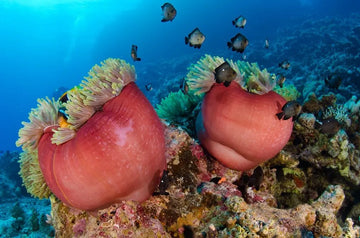Hurghada is a town located at the entrance to the Gulf of Suez, about 65 kilometers southwest of the southern tip of the Sinai Peninsula, near Sharm El Sheikh. It's an area that has transitioned from a fishing village to a major tourist destination, thanks to diving, becoming the main entry point for liveaboard trips for both northern and southern routes of the Red Sea. By the way, remember for Red Sea enthusiasts, its diving spots, and fauna, we have a unique and extra original collection of T-shirts inspired by the Red Sea :-)
Hurghada's attractions for divers are numerous, making it today the second most sought-after destination in the Red Sea. Diving enthusiasts keen on wrecks find paradise in Hurghada, comparable, albeit at a distance, only to Truk Lagoon. The wrecks found in this area are of world-class quality such as the Salem Express, Giannis D, or Carnatic, but you can also enjoy beautiful coral gardens, encounters with pelagic species like the oceanic whitetip shark, turtles, dolphins, colorful tropical fish, and walls abundant with gorgonians.
Although Hurghada is typically visited via liveaboard diving, another interesting option is staying in a resort that also allows for off-gassing nitrogen in an excursion to the Temple of Luxor or the Valley of the Kings.
Diving Areas in Hurghada
______________________
The best liveaboard offers in the Red Sea
______________________
Wrecks
Abu Nuhas
In the Shadwan Channel, we find a reef that seems to attract shipwrecks. Up to seven freighters lie on the seabed for the enjoyment of thousands of divers. These wrecks have been colonized by both hard and soft corals, and a multitude of fish have made these remains their home. Napoleon fish, stonefish, anthias, batfish, emperor angelfish, nudibranchs, octopuses, dolphins, or turtles find an ideal ecosystem in these wrecks.

Salem Express
This wreck has an air of mystery capable of overwhelming any diver. The sinking of the Salem Express claimed the lives of 470 people in 1991 in one of the greatest maritime tragedies in the Red Sea. Diving at this wreck is a unique experience, unlike any other shipwreck. We can still find personal belongings of the passengers, and curiously, even though we can see some emperor angelfish, frogfish, or clownfish, the underwater life hasn't colonized the remains, perhaps in acknowledgment of the tragedy of this very recent sinking.
Rosalie Moller
The Rosalie Moller is one of the remnants left by World War II at the bottom of the Red Sea and has become a delight for the most experienced divers. This 110-meter-long freighter was carrying coal when, in 1940, near Gubal Island, it was bombed by two German planes, in the same operation that sent the legendary Thistlegorm to the bottom of the sea. The Rosalie Moller now rests at a depth of 50 meters and is considered one of the best deep diving spots in the Red Sea.
Ulysses
The Ulysses has been sunk in the Red Sea for over a century, attached to one of the most beautiful reefs, Bluff Point, and stands out due to the large quantity of both hard and soft corals that have colonized its remains and the precious species that have made this wreck their home. Turtles, dolphins, toadfish, lionfish, trumpetfish, large schools of small fish... It's a great opportunity to see a summary of the great biodiversity offered by the Red Sea.
Coral Reefs

Shaab El Erg
Shaab El Erg is a 5-kilometer-long reef whose main attraction is diving with resident bottlenose dolphins. In its seven dive sites, you can witness healthy coral gardens, tropical fish (such as the Red Sea bannerfish, endemic to this area), turtles, mobulas, and occasionally a reef shark.
Bluff Point
Bluff Point is becoming an increasingly popular diving spot due to its shallow depth, allowing for longer dives, the abundance of marine life, and its location on the way to one of the stars of diving in the Red Sea, the Thistlegorm. Here, you can find turtles, lionfish, numerous nudibranchs, large moray eels, and even stonefish.
Carless Reef
Carless Reef is an isolated reef that receives nutrient-rich waters and is of great interest due to the abundance of marine life it holds. Healthy hard and soft corals host a wide range of reef life, with two undeniable stars, two very curious moray eels with the divers. This colorful reef attracts dolphins, longimanus sharks, or schools of tunas when the currents are strong.
Panorama Reef
Panorama Reef is a large reef with steep walls full of healthy coral. Its name refers to the beauty of this reef seen from the blue... and also the beauty of the blue seen from the reef. In addition to a great amount of colorful and small fauna, you can have wonderful encounters with gray reef sharks, longimanus sharks, occasionally hammerheads, and even manta rays.





















